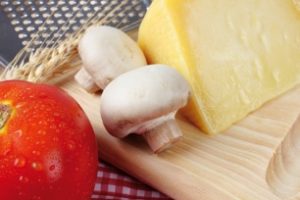
Sometimes the words used when talking about glutamate and umami are a little unfamiliar. Here’s a look at the meaning of the ones you’re most likely to encounter so you can be in the know.
Glutamate – Glutamate is the common name for glutamic acid, an amino acid found in nearly all protein-containing food. It is also naturally produced by the human body.
Glutamic acid – Glutamic acid is one of the most common amino acids, which are the building blocks of proteins. It’s also called glutamate.
Amino acids – Amino acids bind together to form proteins. There are 22 different amino-acids. Eight of them are called “essential” because we need them to live but the human body can’t produce them, so they must be obtained from food. The other 14 amino acids are considered “non-essential” because they can be gotten from food or made by the body. Glutamate is a non-essential amino acid.
MSG – Monosodium glutamate, or MSG, is a salt that contains glutamate. It is an isolated purified form of glutamate that when added to food adds umami (savory) flavor.
Umami – Umami is a pleasant savory taste that comes from glutamate and ribonucleotides like inosinate and guanylate. It’s a subtle flavor that blends well with other tastes to expand and round out the flavor of foods. Most people have trouble describing the flavor of umami, but instinctively recognize foods with it as being delicious.
Bound glutamate – Bound glutamate is glutamate that is linked to other amino acids forming a protein molecule. This type of glutamate does not contribute umami flavor.
Free glutamate – Free glutamate is glutamate that is not linked to other amino acids in a protein molecule. Only free glutamate – not bound – enhances the umami flavor of food. Foods often used for their savory flavor, such as tomatoes and mushrooms, have naturally high levels of free glutamate.
Fermentation – Fermentation is a process in which yeast or bacteria consume carbohydrates and in turn produce a different substance. In the case of MSG, bacteria eat carbohydrates from crops like corn or sugar beets/cane to make glutamate, which is purified and crystallized before being sold as a seasoning powder. Products like vinegar, yogurt and beer are also made through fermentation.
Hydrolyzed proteins – Hydrolyzed proteins are proteins that have been broken down into amino acids. Because this process releases free glutamate, hydrolyzed proteins can be used in foods to enhance the umami flavor.
Yeast extract – Yeast extract is the inner contents of yeast cells that is left after the cell walls have been removed. Because yeast extract contains a lot of free glutamate, it’s used to add umami flavor to food.
Ribonucleotides – Disodium 5’-ribonucleotides is a mixture of disodium inosinate and disodium guanylate that enhances umami flavor when used with MSG. A mixture of ribonucleotides and MSG together works synergistically to allow umami flavor to be sensed more strongly than if each of the ingredients were used individually.
Inosinate – Inosinate is a ribonucleotide that is naturally found in meat and fish and has an umami flavor. It sometimes used with MSG to enhance the umami flavor, and is often used in conjunction with guanylate, another ribonucleotide.
Guanylate – Guanylate is a ribonucleotide that is naturally found in mushrooms and has an umami flavor. It is frequently used in conjunction with inosinate and MSG to enhance umami flavor.
* * * *
For Further Reading…

Glutamate: No Reason to Fear, Every Reason to Enjoy
“Consumers love hearing about the flavor benefits of ‘umami’. I’ve had such conversations with my patients and also friends and acquaintances. When they know about umami, they’re onboard all the way. If I speak of something like ‘MSG’ or monosodium glutamate, however, they grimace tightly. ‘Wow, that’s bad for you’ or ‘I don’t eat anything with MSG,’ are common reactions. That’s when I know they’re misinformed and getting their food information from sources that are inaccurate, to say the least.” Read on.
Although virtually every food will contain some amount of glutamate, there are some foods that are rich in glutamate and can easily be combined in your favorite recipes. Find out about the most common glutamate-rich foods.


